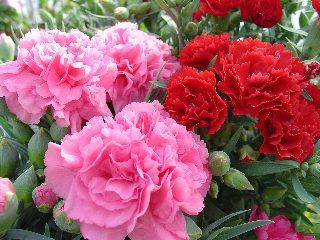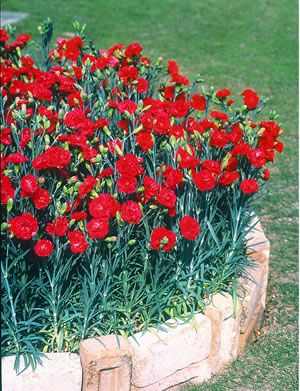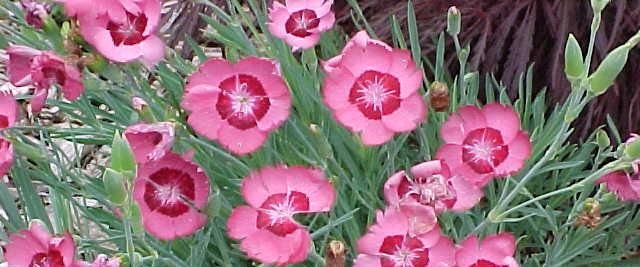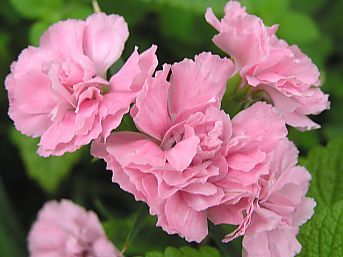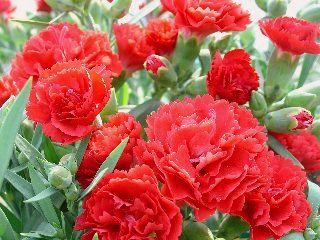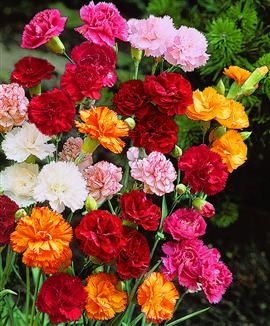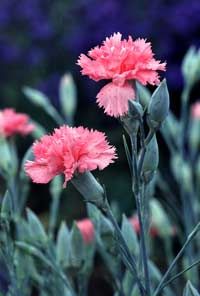Garoafa - Dianthus Caryophyllus
Denumire populara:
garoafa,
garoafa de gradinaFamilie: Caryophyllaceae
Inaltime: 45-60 cm
Diametru: 38-45 cm
Expunere: plin soare
Sol: 6,6-7,5 (neutru), 7,6-7,8 (usor alkalin)
Udare: medie - nu exagerati; la intervale regulate
Perioada de inflorire: primavara tarziu - vara
Foliaj: verde, verge-albastrui
DescriereGaroafele sunt un gen de plante care infloreste anual, de doua ori pe an sau in continuu.
Garoafa are frunze ascutite, lanceolate, de culoare gri-verzui, asezate de-a lungul tulpinii; frunzele se intorc usor in afara. Florile pot fi parfumate, simple sau duble, de mai multe culori. Exista multi hibrizi de
garoafa care nu au parfum, dar au o varietate mai mare de culori.
Garoafele infloresc mai ales in perioadele cu temperaturi mai scazute ale anului, la inceputul iernii. Sunt plante perfecte pentru gradina, dar si ca flori taiate. Daca sunt ingrijite corespunzator,
garoafa rezista in glastre chiar si o luna.
Originare din Eurasia,
garoafele sunt unele din cele mai populare flori de gradina si se numara prin cele aproape 300 de specii de plante anuale, bianuale sau perene ale genului Dianthus. Exista sute de varietati si hibrizi. In limba greaca, "dianthus" inseamna "floarea lui Zeus" sau "floarea divina".
Garoafele pot atinge 60-90 cm inaltime, desi majoritatea varietatilor cultivate in gradina ating 25-50 cm.
Ingrijire si cultivareGaroafa este printre cele mai cautate flori; ele au atat valoare comerciala cat si ornamentala. Gradinarii nu stiu in general tehnicile de cultivare a garoafelor si conditiile de care au nevoie acestea.
Garoafele sunt potrivite ca plante de bordura, in straturi, in gradini cu rocarie si chiar in ghivece. Ele se gasesc intr-o varietate de culori cum ar fi rosu, caramoziu, portocaliu, violet, galben, roz, alb, crem, etc.
Garoafele au nevoie de pamant fertil, usor alkalin sau neutru din punctul de vedere al pH-ului, usor drenabil si de 4-5 ore de plin soare, zilnic.
Pamantul trebuie sa fie umed. Evitati sa udati in exces florile, pentru ca acest lucru va duce la ingalbenirea foliajului. Pentru ca sa infloreasca in continuu,
garoafele trebuie tratate usor cu o substanta fertilizatoare lichida (10-10-10), la fiecare 6-8 saptamani. Florile trecute, ofilite, trebuie inlaturate repede pentru a incuraja inflorirea continua.
Un alt aspect important este ciupirea florilor.
Garoafele trebuie ciupite pana au numai 6 noduli pe fiecare tulpina - aceasta operatie incurajeaza dezvoltarea tulpinilor laterale, ramificatia tufei in general. La fel, si tulpinile laterale trebuie ciupite. Nu uitati ca daca tufa are mai multe tulpini, va avea si mai multe flori. De asemenea, la inceput, planta trebuie legata de un bat pentru a creste dreapta. Daca se doresc flori mai putine, la capatul unei tulpini lungi, atunci garoafa se ciupeste o data, cand are 15 cm inaltime, si apoi inca o data cand tulpinile laterale au 10-15 cm (cam la 4 saptamani dupa prima "ciupire"). Odata plantata, garoafa trebuie udata la fiecare 5-7 zile. In ghiveci, udarea trebuie facuta la 3-5 zile.
Daca
garoafa este crescuta la planta de apartament, trebuie sa aveti mare grija la conditiile de temperatura si umiditate din incaperea in care este asezat ghiveciul. Aerul prea uscat dauneaza foarte mult garoafelor; acest lucru se poate regla prin stropirea frunzelor si asezarea ghiveciului intr-o pozitie in care sa nu fie expusa la surse de caldura sau la soare direct.
Metode de inmultire1.
Seminte. Pentru a colecta semintele, lasati capetele garoafelor sa se usuce pe planta, dupa care se taie si se aduna semintele. Daca sunt curatate corespunzator, acestea pot fi chiar pastrate mai mult timp. Se pot planta in interior, inainte de ultimul inghet, la 3 mm adancime, intr-un amestec usor drenabil, primavara sau la inceputul verii. Compostul trebuie sa fir umed dar nu exagerat de ud. Eventual, stropiti cu apa pentru a-i mentine umiditatea. Semintele vor germina in 2-3 saptamani. Cand rasadurile au crescut destul de mult, garoafele pot fi transplantate in ghivece sau drirect in pamant. Ele vor inflori in 6-9 luni sau chiar un an.
2.
Butasi. Acestia se recolteaza de la orice
garoafa, dar cei mai calitativi sunt cei de pe plantele de un an, dupa ce aceasta a inflorit. De fapt, tulpina florii este de cele mai multe ori singurul element din care garoafa isi va dezvolta o alta tulpina destul de lunga, capabila sa infloreasca la randul ei. Butasii se preleveaza cel mai bine la inceputul toamnei. Ei vor prinde radacini de la nodul umflat ascuns sub fiecare frunza. Faceti o taietura inclinata (nu dreapta!) imediat sub un nod si indepartati partea de sus, lasand inca un nod din care sa creasca tulpina noua. Butasul se infige intr-un ghiveci cu pamant usor drenabil, sau intr-o rasadnita.
3.
Marcotaj. Este cea mai simpla metoda de inmultire a
garoafelor, aplicabila numai cand planta s-a maturizat complet. La o tufa de garoafe, cautati tulpinile care stau desprinse de grup sau care cad inspre pamant. Este posibil ca acestia sa fie deja inradacinati, dar daca nu, iata ce trebuie sa faceti: aplecati tulpinile pana ating pamantul si fixati-i cu o piatra sau, mai bine, cu un carlig de fier; taiati toate florile care cresc pe tulpina respectiva. In cateva saptamani, veti vedea ca garoafa a prins radacini. O alta metoda, usor diferita este ca tulpina sa fie putin ingropata in pamant. Odata de radacinile ating 10-12 cm lungime, taiati noua planta si transplantati-o intr-un ghiveci sau in gradina, in pamant usor drenabil.
4.
Garoafele mai pot fi inmultite prin divizarea radacinilor. Scoateti din pamant ghemul de radacini si impartiti-l cu grija, cu mana sau cu o foarfeca de gradina. Fiecare segment de replanteaza intr-un amestec usor drenabil, care trebuie mentinut mereu umed.
Lavinia Rorich
Gradinamea.ro

